The global portable audiometer calibration system market is valued at USD 96.2 million in 2025. It is projected to reach USD 131.8 million by 2035, expanding at a compound annual growth rate of 3.2% and generating an absolute dollar opportunity of USD 35.6 million over the forecast period. Market growth is supported by the rising need for portable, precise, and field-deployable calibration equipment used in clinical audiology, occupational health testing, and acoustic research.
Healthcare facilities and industrial programs increasingly depend on portable systems to maintain consistent calibration standards outside traditional laboratories. This shift is driven by expanding hearing assessment services in community clinics, schools, and mobile healthcare units. Product design trends emphasize reduced size, extended battery operation, and automated verification functions to improve field reliability and workflow efficiency.
Manufacturers are focusing on compliance with evolving international standards for audiometric calibration, including ISO and ANSI specifications, as institutions prioritize traceability and measurement accuracy. Regional growth patterns show consistent demand from North America and Europe, where stringent regulatory frameworks govern device validation. Emerging markets in Asia Pacific are expected to contribute additional volume as local audiology services expand. Stable production capacity, component sourcing, and calibration software updates remain central to sustaining operational performance and cost control through 2035.
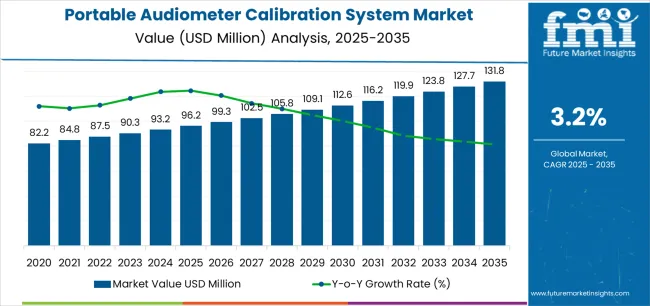
Between 2025 and 2030, the portable audiometer calibration system market is expected to expand from USD 96.2 million to USD 109.1 million, marking a growth of USD 12.9 million, which represents 45.9% of the total forecast expansion for the decade. This growth period will be driven by the increasing demand for portable, high-precision calibration systems that support the growing network of hearing care clinics, hospitals, and mobile diagnostic units. Advancements in sensor accuracy, miniaturized calibration modules, and wireless data synchronization will enhance operational efficiency. Key players are investing in lightweight, field-ready systems that meet evolving international audiometric testing standards.
From 2030 to 2035, the market is projected to grow further from USD 109.1 million to USD 131.8 million, contributing USD 22.7 million, or 54.1% of the decade’s overall increase. This phase will see the growing adoption of automated and AI-integrated calibration systems, enabling real-time verification and performance tracking of audiometric equipment. Expansion of teleaudiology services and decentralized hearing assessment models will accelerate product demand. Strategic collaborations between calibration device manufacturers and audiology service providers will support innovation in precision calibration technology, ensuring reliability, portability, and regulatory compliance across global auditory care applications.
| Metric | Value |
|---|---|
| Market Value (2025) | USD 96.2 million |
| Market Forecast Value (2035) | USD 131.8 million |
| Forecast CAGR (2025–2035) | 3.2% |
The portable audiometer calibration system market is growing due to increasing demand for precise, on-site calibration solutions within hearing care, audiology, and occupational health sectors. Audiometers used in clinics, hospitals, and industrial hearing conservation programs require regular calibration to maintain measurement accuracy and meet compliance standards set by organizations such as ISO and ANSI. Portable calibration systems allow technicians to verify and adjust equipment performance without returning units to centralized laboratories, reducing downtime and operational costs for healthcare providers and testing facilities.
Manufacturers are developing compact, digitally controlled calibration units that integrate automated testing functions and data recording capabilities, enabling consistent traceability and faster field verification. The rising prevalence of hearing disorders and expanding screening programs, particularly in aging populations and high-noise industries, increase reliance on audiometric devices and, in turn, on portable calibration solutions. Government regulations mandating routine equipment certification also reinforce market adoption. Technological improvements in digital signal processing and sensor precision enhance calibration accuracy while minimizing operator input. However, limited awareness among smaller clinics and the high initial cost of advanced portable units may slow adoption in developing regions. Overall, consistent regulatory enforcement and healthcare modernization sustain steady market growth worldwide.
The portable audiometer calibration system market is segmented by product type and application. By product type, the market is divided into analog signal and digital integration systems. Based on application, it is categorized into field calibration and maintenance, hospital and clinical audiology, and others. These segments define the operational focus and technology adoption patterns in portable calibration systems used for precise audiometric equipment verification.
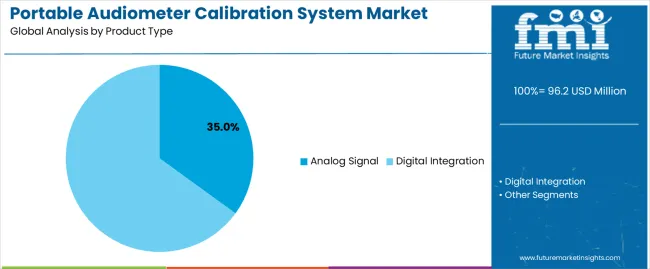
The analog signal segment accounts for approximately 35.0% of the global portable audiometer calibration system market in 2025, representing the leading product category. This dominance reflects the sustained use of analog-based calibration systems across field and institutional environments where simplicity, reliability, and compatibility with legacy audiometers remain priorities. Analog signal calibration devices continue to be preferred for routine testing due to their operational stability and straightforward measurement interface.
These systems are widely used by service providers conducting on-site calibration of audiometric instruments, particularly in regions where analog audiometers remain prevalent. The segment’s market position is further supported by its adaptability to various calibration standards and minimal power requirements, enhancing portability and usability. While digital integration systems are gaining adoption for data automation and precision measurement, analog solutions maintain steady demand in cost-sensitive markets and mobile service operations. The ongoing requirement for dependable and easily maintainable calibration equipment sustains the analog segment’s relevance, especially within decentralized testing frameworks and periodic maintenance programs in audiological practices.

The field calibration and maintenance segment represents about 30.0% of the total portable audiometer calibration system market in 2025, holding the largest share by application. This segment’s position is supported by the continuous need for accurate verification of audiometric equipment outside fixed laboratory settings. Portable calibration systems are frequently deployed by technicians to ensure compliance with testing standards such as ISO 8253 and ANSI S3.6 during on-site maintenance.
Demand from occupational health programs, mobile hearing assessment units, and institutional service providers contributes to segment growth. The portability and operational efficiency of modern calibration devices enable reliable field performance checks without requiring full laboratory setups. The field calibration and maintenance application remains essential for sustaining accuracy across dispersed testing locations, supporting consistent audiometric results in industrial, clinical, and community screening contexts. This segment continues to define the core operational demand within the market as regulatory emphasis on calibration traceability and device performance verification strengthens across the global audiology equipment sector.
The portable audiometer calibration system market is expanding as the demand for precise and mobile hearing test calibration increases. Growth in audiology testing, occupational health screening, and remote hearing assessment has raised the need for compact, efficient calibration tools. Regulatory standards requiring consistent calibration of diagnostic equipment further support market adoption. Cost, training, and operational limitations remain notable challenges, particularly in small-scale facilities. The market is trending toward compact, automated, and digitally connected calibration systems, reflecting broader healthcare shifts toward portability, efficiency, and compliance-focused technology.
Growth is driven by the rising prevalence of hearing impairment and the increasing requirement for standardized testing accuracy. Healthcare and industrial programs focused on early hearing loss detection rely on portable audiometers for field use, creating a parallel need for portable calibration solutions. Regulatory compliance standards mandate regular calibration, encouraging consistent product demand. The expansion of hearing care infrastructure in developing regions also contributes to growth. Collectively, these factors reinforce the adoption of portable calibration systems as essential tools for ensuring measurement reliability in diverse testing environments.
High product cost and the technical skill required for operation limit broader market penetration. Smaller clinics and remote facilities may find advanced calibration systems financially restrictive, slowing overall adoption. Maintenance, periodic verification, and the need for trained personnel add operational complexity. In regions with limited audiology expertise, lack of standardized procedures further constrains usage. These factors collectively restrict accessibility for lower-tier users, even as regulatory obligations and testing needs increase, creating a gap between capability and implementation.
Technological innovation is shaping the next phase of market development through greater automation, portability, and digital integration. Manufacturers are introducing compact calibration systems with wireless data transfer and user-friendly interfaces to enhance mobility and reduce manual error. Remote calibration and cloud-based verification are emerging as practical options for decentralized testing environments. Miniaturization and battery efficiency improvements enable frequent on-site use, extending applicability beyond clinical laboratories. As calibration becomes embedded in broader diagnostic workflows, digital connectivity and operational simplicity define the leading edge of market evolution.

| Country | CAGR |
|---|---|
| China | 4.3% |
| India | 4.0% |
| Germany | 3.7% |
| Brazil | 3.4% |
| USA | 3.0% |
| UK | 2.7% |
| Japan | 2.4% |
The Portable Audiometer Calibration System Market is witnessing steady expansion globally, with China leading at a 4.3% CAGR through 2035. Growth is fueled by increased investment in audiological healthcare, technological innovation, and the rise of portable diagnostic systems. India follows at 4.0%, supported by expanding healthcare infrastructure, government screening programs, and growing awareness of hearing health. Germany records 3.7%, driven by precision engineering and strong adoption in clinical settings. Brazil shows 3.4% growth, reflecting improved healthcare accessibility and training adoption. The U.S., at 3.0%, maintains market maturity with advancements in calibration technology, while the U.K. (2.7%) and Japan (2.4%) emphasize product standardization, research excellence, and efficient diagnostic calibration practices.
The report covers an in-depth analysis of 40+ countries top-performing countries are highlighted below.
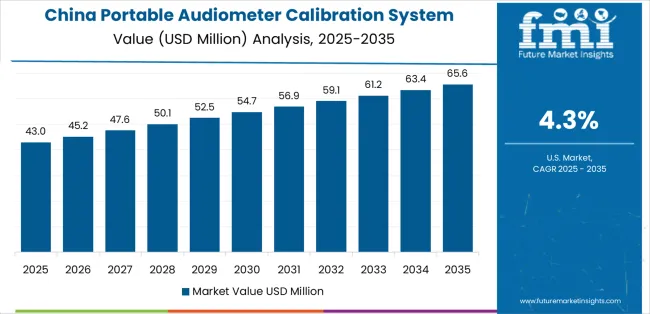
Revenue from portable audiometer calibration systems in China is projected to grow at a CAGR of 4.3% through 2035, supported by ongoing healthcare infrastructure expansion and adoption of advanced diagnostic calibration technologies. Increasing investment in hearing assessment and audiology departments across hospitals and research institutions is stimulating demand. Government-led healthcare modernization programs are enhancing access to precision diagnostic tools in regional and urban centers. Domestic manufacturers are expanding production capacity to improve system availability and meet national technical standards.
Revenue from portable audiometer calibration systems in India is increasing at a CAGR of 4.0%, driven by rising demand for reliable hearing testing and calibration equipment across healthcare and educational institutions. Growth in audiology training programs and hearing clinics is creating sustained need for portable calibration systems. Government initiatives focused on hearing care accessibility and community-based screening programs are expanding the user base. Manufacturers are strengthening distribution networks to serve regional diagnostic centers and specialized hearing clinics.

Revenue from portable audiometer calibration systems in Germany is expanding at a CAGR of 3.7%, supported by the country’s established medical device manufacturing standards and advanced clinical calibration practices. Hospitals, research institutes, and audiology centers are adopting portable systems for accurate and repeatable measurement. Strong technical regulations and quality assurance requirements sustain equipment demand. German manufacturers continue to focus on system precision, data integrity, and ease of field use.
Revenue from portable audiometer calibration systems in Brazil is projected to rise at a CAGR of 3.4%, supported by national programs aimed at improving diagnostic infrastructure and hearing healthcare access. Hospitals and clinics are adopting portable calibration systems to strengthen field testing and community outreach programs. Government-supported health initiatives are expanding audiology service coverage in underserved areas. Local distributors are improving system availability through partnerships with international equipment suppliers.
Revenue from portable audiometer calibration systems in the United States is growing at a CAGR of 3.0%, supported by advanced clinical infrastructure and strict calibration compliance standards. The country’s focus on precision in audiological measurement is driving demand for portable, high-accuracy systems used in hospitals, military facilities, and mobile testing programs. Manufacturers are integrating automated verification technologies to align with national calibration guidelines.
Revenue from portable audiometer calibration systems in the United Kingdom is advancing at a CAGR of 2.7%, supported by established hearing research programs and standardized calibration procedures within the National Health Service. Medical institutions and research organizations employ portable systems for on-site verification and equipment quality assurance. Continuous updates to testing standards and clinical best practices sustain product relevance.
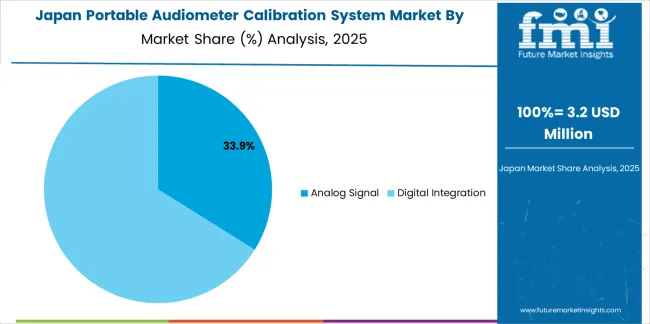
Revenue from portable audiometer calibration systems in Japan is increasing at a CAGR of 2.4%, supported by the country’s precision engineering capabilities and strong focus on clinical reliability. Hospitals, universities, and hearing aid centers are investing in portable calibration equipment for on-site testing accuracy. Manufacturers emphasize high-quality materials, user-friendly design, and precise measurement standards. Market growth remains steady due to consistent equipment replacement cycles and adherence to national calibration regulations.
The global portable audiometer calibration system market is characterized by fragmented competition among acoustic instrumentation specialists, calibration equipment manufacturers, and audiometric technology providers. GRAS Sound & Vibration leads the market with an estimated 8% share, supported by its specialization in precision acoustic measurement and mobile calibration systems designed for clinical and industrial use. Norsonic and Larson Davis maintain strong competitive positions through their expertise in sound level calibration and portable acoustic analysis instruments. Aussco and Kiversal focus on user-oriented calibration systems tailored for healthcare and hearing assessment applications. Brüel & Kjær complements its parent company’s portfolio with high-fidelity sound measurement equipment, enhancing its reach in audiometric calibration and compliance testing.
Tremetrics and Grason-Stadler deliver integrated audiometric solutions incorporating calibration functions within diagnostic systems, addressing medical and occupational health markets. Benson Medical and Hangzhou AIHUA Instruments Co., Ltd. provide portable calibration tools with emphasis on accessibility and regional distribution coverage. Listen, Inc. and NTi Audio strengthen their competitiveness through software-driven calibration platforms and precision signal processing technology. Precision Acoustics and PCB Piezotronics concentrate on laboratory-grade measurement standards, supporting product verification and system accuracy. Svantek and Frye Electronics serve specific audiometric and acoustic compliance niches, while Rion Co., Ltd. maintains a consistent presence in Asia through portable sound calibration instruments. Competitive advantage in this market is shaped by accuracy, portability, calibration traceability, and digital interface integration, while continued innovation in automated verification systems and wireless connectivity defines its technological trajectory.
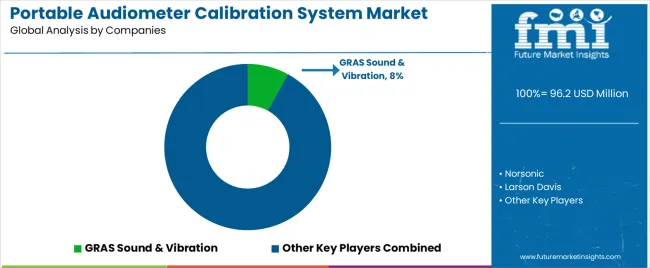
| Items | Values |
|---|---|
| Quantitative Units (2025) | USD 96.2 million |
| Type (Product Type) | Analog Signal, Digital Integration |
| Application | Field Calibration and Maintenance, Hospital and Clinical Audiology, Others |
| Regions Covered | East Asia, Europe, North America, South Asia, Latin America, Middle East & Africa, Eastern Europe |
| Countries Covered | China, India, USA, Germany, Japan, UK, Brazil, South Korea, Italy, and 40+ countries |
| Key Companies Profiled | GRAS Sound & Vibration, Norsonic, Larson Davis, Aussco, Kiversal, Brüel & Kjær, Tremetrics, Grason-Stadler, Benson Medical, Hangzhou AIHUA Instruments Co. Ltd., Listen Inc., NTi Audio, Precision Acoustics, PCB Piezotronics, Svantek, Frye Electronics, Rion Co. Ltd. |
| Additional Attributes | Dollar sales by product type and application categories; regional adoption trends across East Asia, Europe, and North America; competitive landscape featuring calibration equipment manufacturers and audiometric technology providers; analysis of regulatory compliance influences and healthcare modernization; assessment of product innovations in automation, portability, and digital integration driving calibration accuracy and efficiency. |
The global portable audiometer calibration system market is estimated to be valued at USD 96.2 million in 2025.
The market size for the portable audiometer calibration system market is projected to reach USD 131.8 million by 2035.
The portable audiometer calibration system market is expected to grow at a 3.2% CAGR between 2025 and 2035.
The key product types in portable audiometer calibration system market are analog signal and digital integration.
In terms of application, field calibration and maintenance segment to command 30.0% share in the portable audiometer calibration system market in 2025.






Our Research Products

The "Full Research Suite" delivers actionable market intel, deep dives on markets or technologies, so clients act faster, cut risk, and unlock growth.

The Leaderboard benchmarks and ranks top vendors, classifying them as Established Leaders, Leading Challengers, or Disruptors & Challengers.

Locates where complements amplify value and substitutes erode it, forecasting net impact by horizon

We deliver granular, decision-grade intel: market sizing, 5-year forecasts, pricing, adoption, usage, revenue, and operational KPIs—plus competitor tracking, regulation, and value chains—across 60 countries broadly.

Spot the shifts before they hit your P&L. We track inflection points, adoption curves, pricing moves, and ecosystem plays to show where demand is heading, why it is changing, and what to do next across high-growth markets and disruptive tech

Real-time reads of user behavior. We track shifting priorities, perceptions of today’s and next-gen services, and provider experience, then pace how fast tech moves from trial to adoption, blending buyer, consumer, and channel inputs with social signals (#WhySwitch, #UX).

Partner with our analyst team to build a custom report designed around your business priorities. From analysing market trends to assessing competitors or crafting bespoke datasets, we tailor insights to your needs.
Supplier Intelligence
Discovery & Profiling
Capacity & Footprint
Performance & Risk
Compliance & Governance
Commercial Readiness
Who Supplies Whom
Scorecards & Shortlists
Playbooks & Docs
Category Intelligence
Definition & Scope
Demand & Use Cases
Cost Drivers
Market Structure
Supply Chain Map
Trade & Policy
Operating Norms
Deliverables
Buyer Intelligence
Account Basics
Spend & Scope
Procurement Model
Vendor Requirements
Terms & Policies
Entry Strategy
Pain Points & Triggers
Outputs
Pricing Analysis
Benchmarks
Trends
Should-Cost
Indexation
Landed Cost
Commercial Terms
Deliverables
Brand Analysis
Positioning & Value Prop
Share & Presence
Customer Evidence
Go-to-Market
Digital & Reputation
Compliance & Trust
KPIs & Gaps
Outputs
Full Research Suite comprises of:
Market outlook & trends analysis
Interviews & case studies
Strategic recommendations
Vendor profiles & capabilities analysis
5-year forecasts
8 regions and 60+ country-level data splits
Market segment data splits
12 months of continuous data updates
DELIVERED AS:
PDF EXCEL ONLINE
Portable Crushers Market Size and Share Forecast Outlook 2025 to 2035
Portable Toilet Rental Market Size and Share Forecast Outlook 2025 to 2035
Portable NIR Moisture Meter Market Forecast and Outlook 2025 to 2035
Portable Appliance Tester (PAT) Market Size and Share Forecast Outlook 2025 to 2035
Portable Boring Machines Market Size and Share Forecast Outlook 2025 to 2035
Portable Charging Units Market Size and Share Forecast Outlook 2025 to 2035
Portable Electronic Analgesic Pump Market Size and Share Forecast Outlook 2025 to 2035
Portable Ramps Market Size and Share Forecast Outlook 2025 to 2035
Portable Buffet and Drop-In Ranges Market Size and Share Forecast Outlook 2025 to 2035
Portable Cancer Screen Devices Market Size and Share Forecast Outlook 2025 to 2035
Portable Hydrogen Powered Generator Market Size and Share Forecast Outlook 2025 to 2035
Portable Milling Machine Market Size and Share Forecast Outlook 2025 to 2035
Portable Power Quality Meter Market Size and Share Forecast Outlook 2025 to 2035
Portable Sandwich Maker Market Size and Share Forecast Outlook 2025 to 2035
Portable Conventional Generator Market Size and Share Forecast Outlook 2025 to 2035
Portable Projector Market Size and Share Forecast Outlook 2025 to 2035
Portable Printer Market Size and Share Forecast Outlook 2025 to 2035
Portable Video Wall Market Size and Share Forecast Outlook 2025 to 2035
Portable Gas Detection Equipment Market Size and Share Forecast Outlook 2025 to 2035
Portable Band Saws Market Size and Share Forecast Outlook 2025 to 2035

Thank you!
You will receive an email from our Business Development Manager. Please be sure to check your SPAM/JUNK folder too.
Chat With
MaRIA